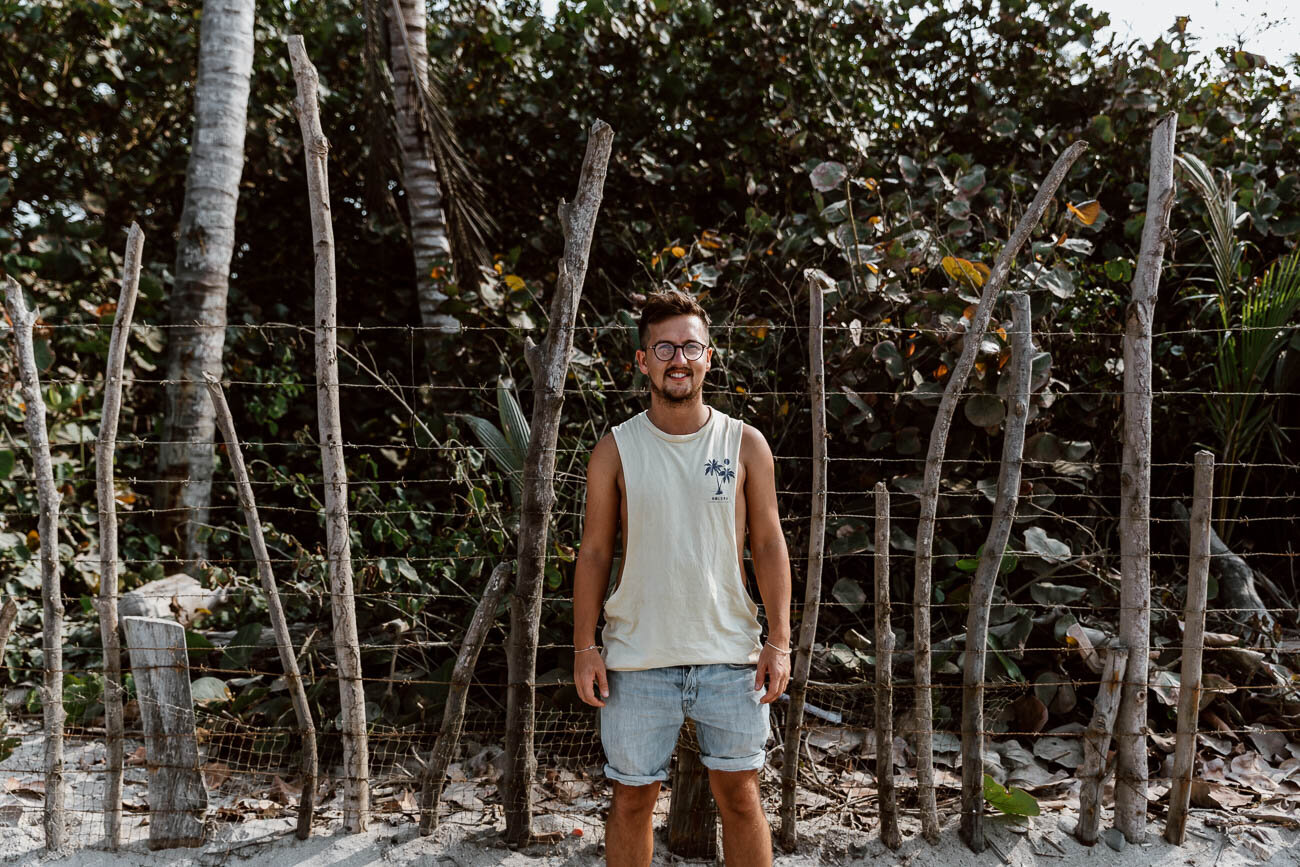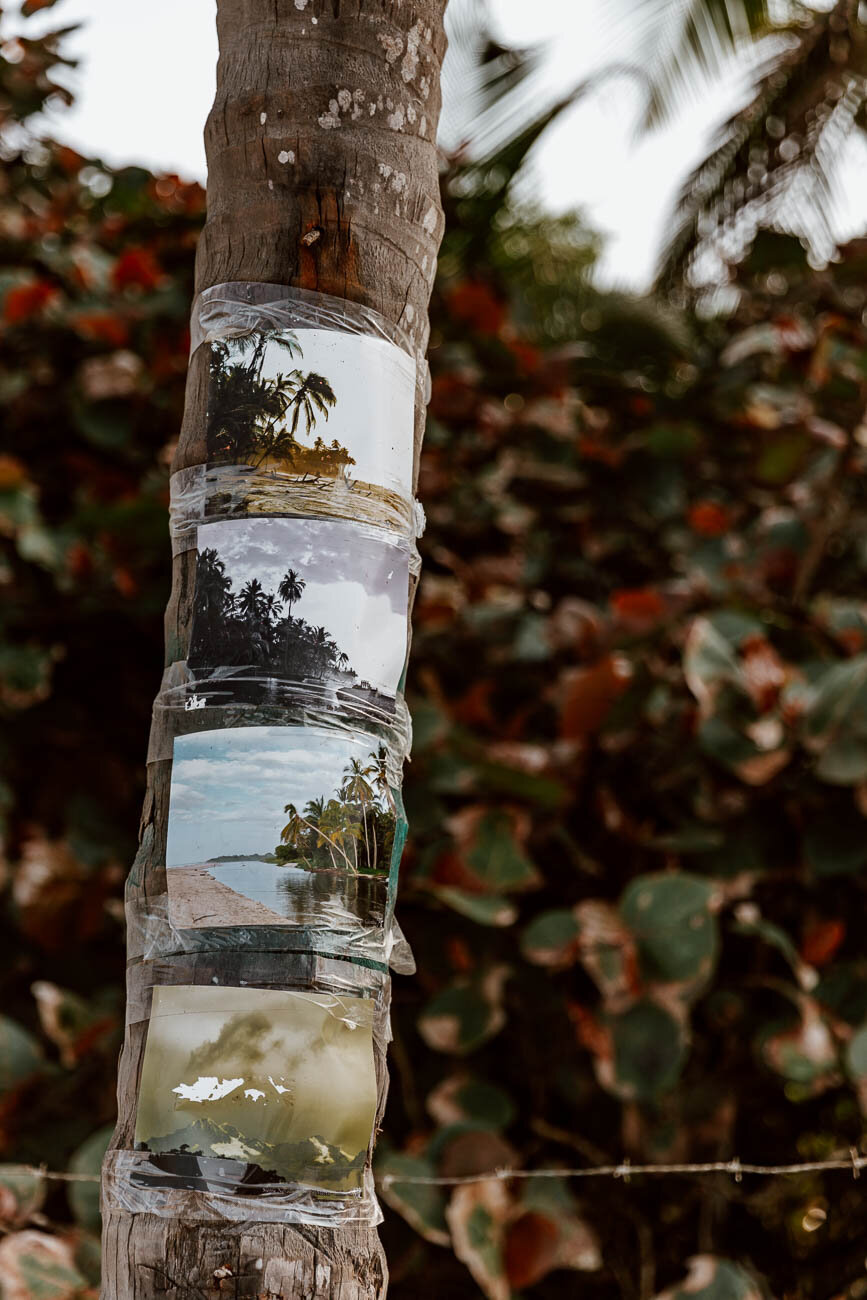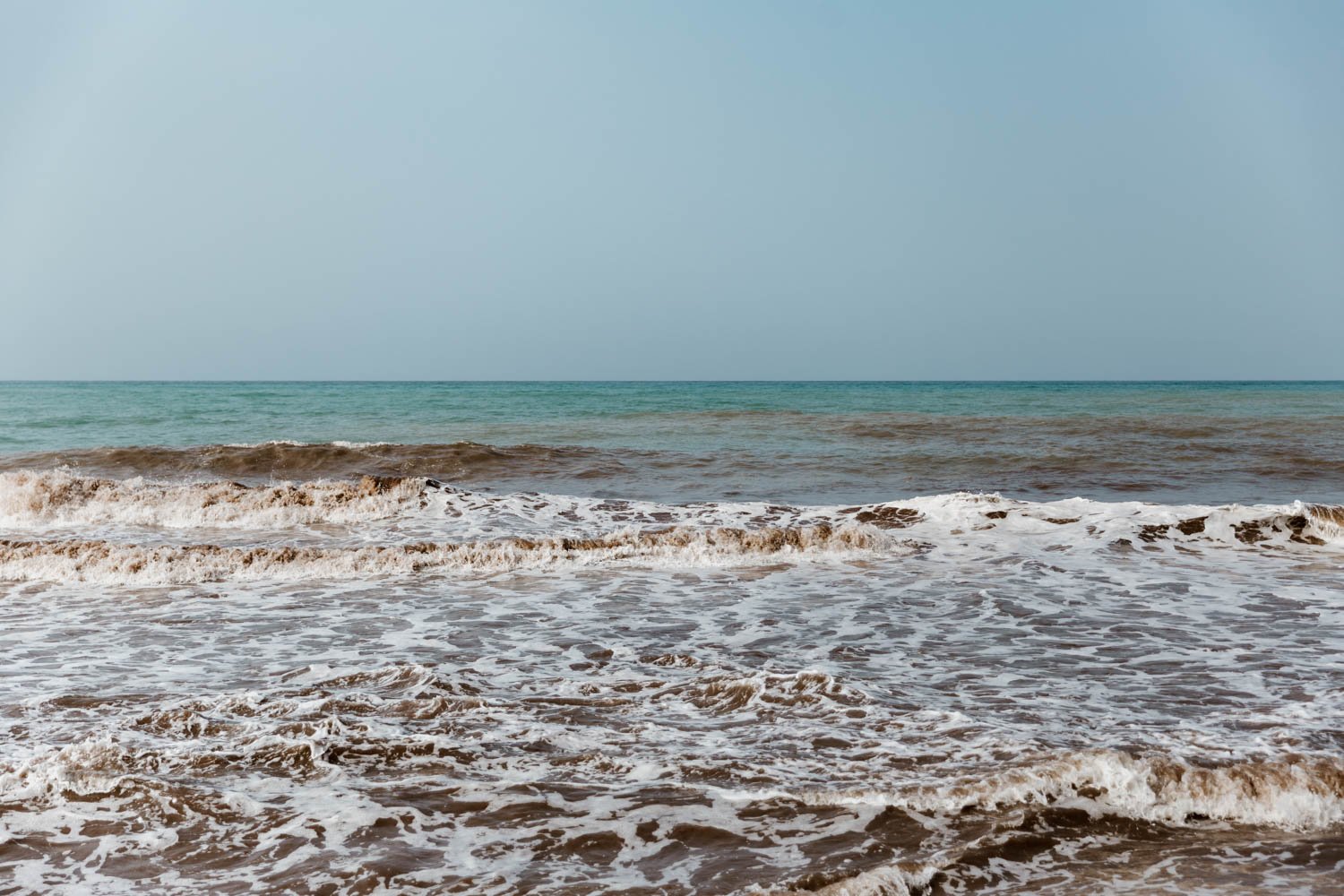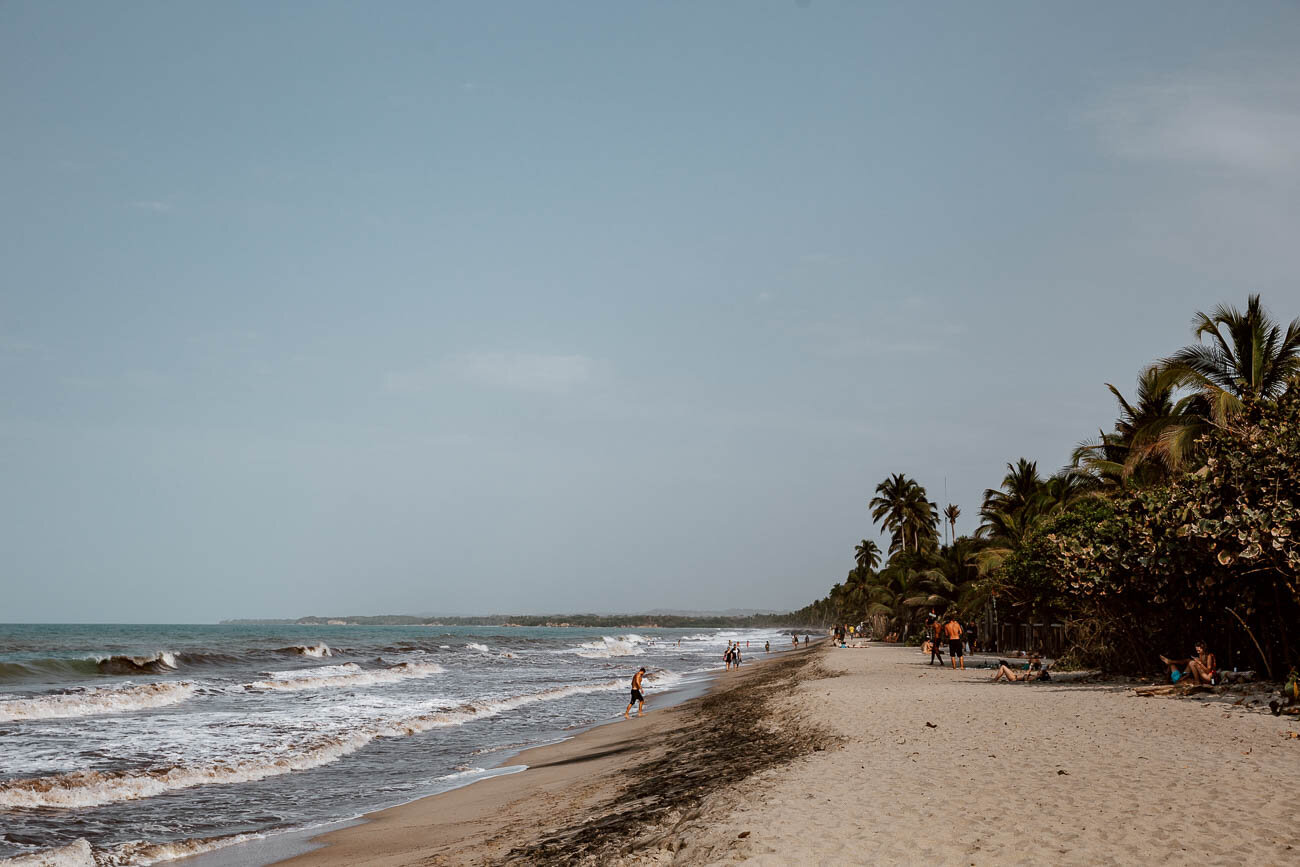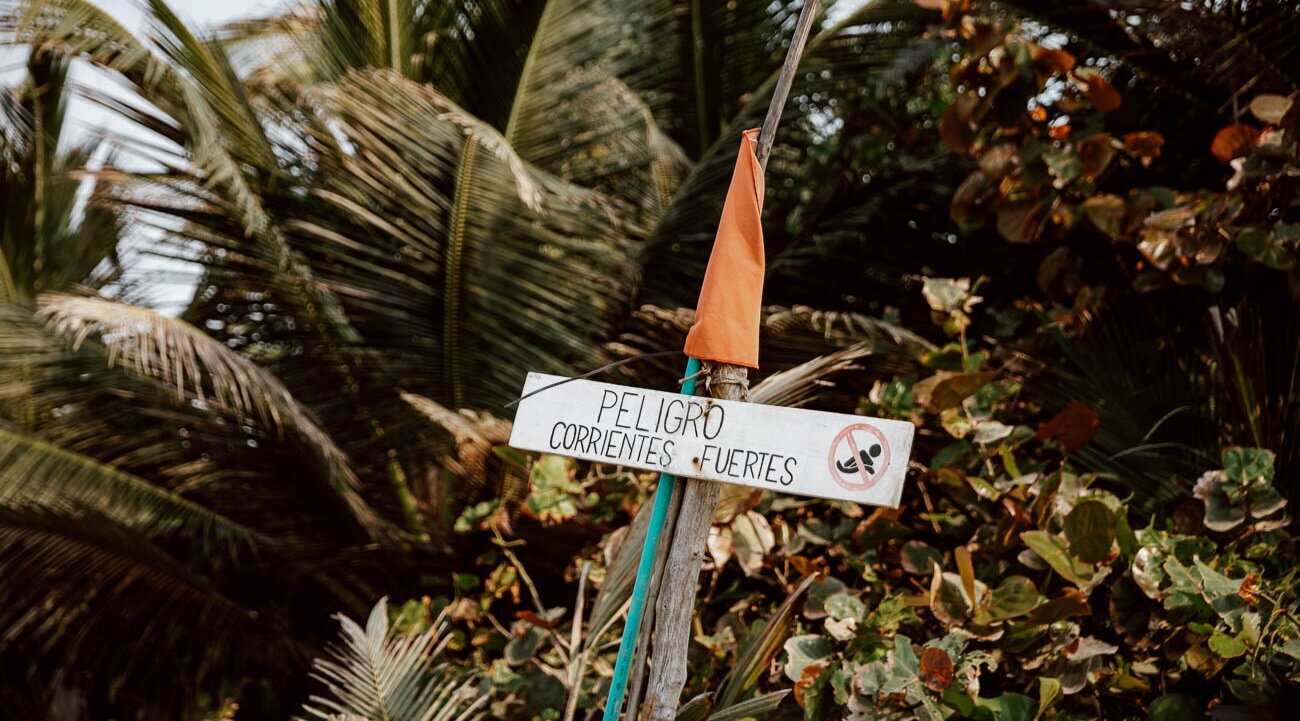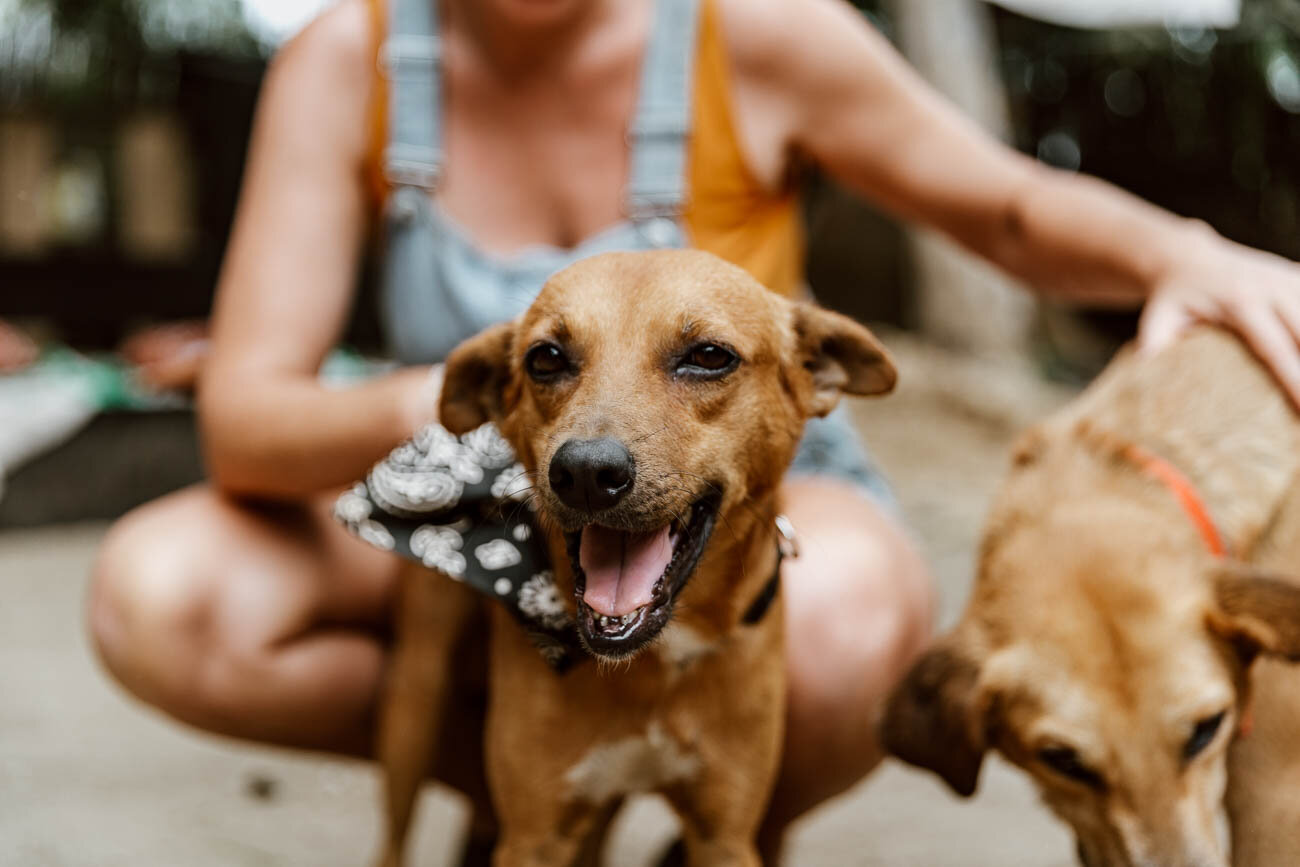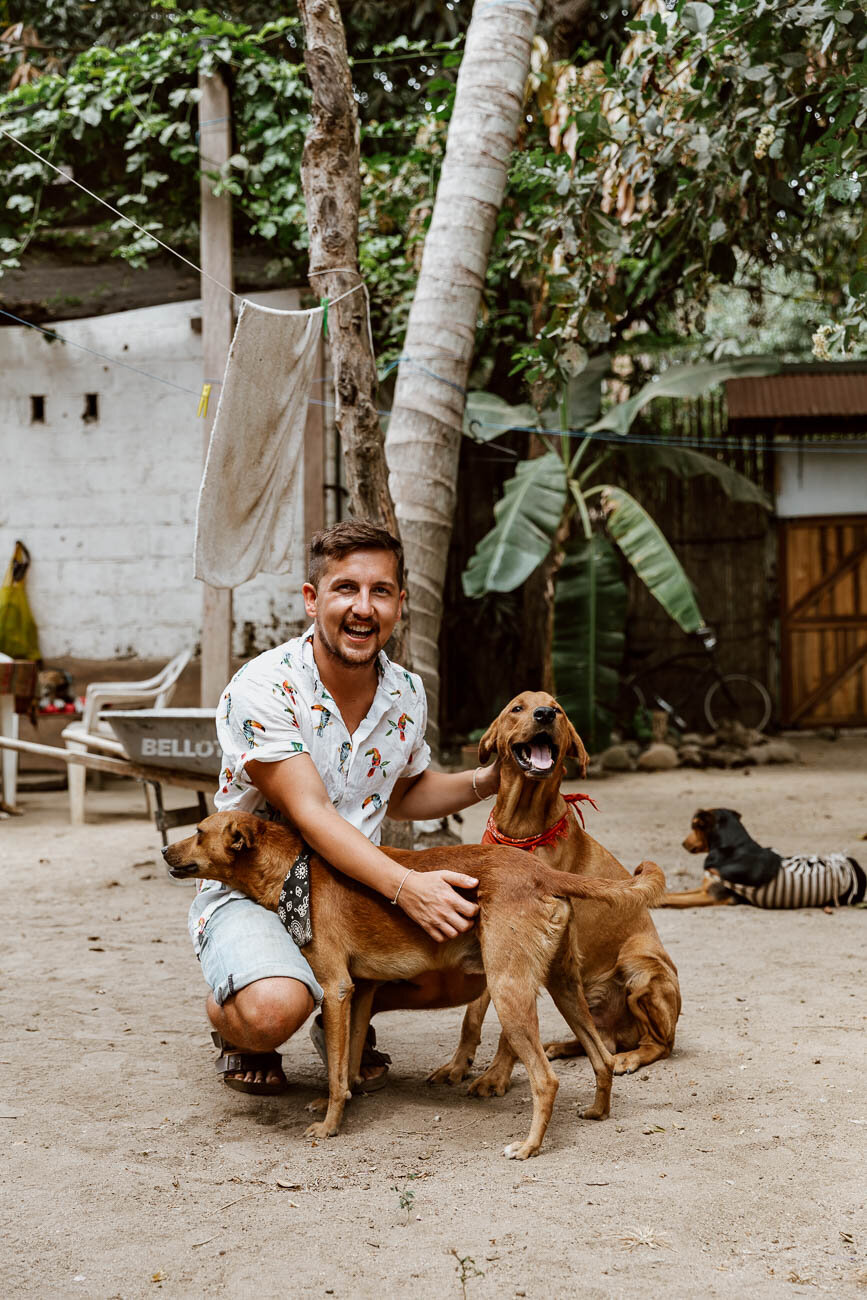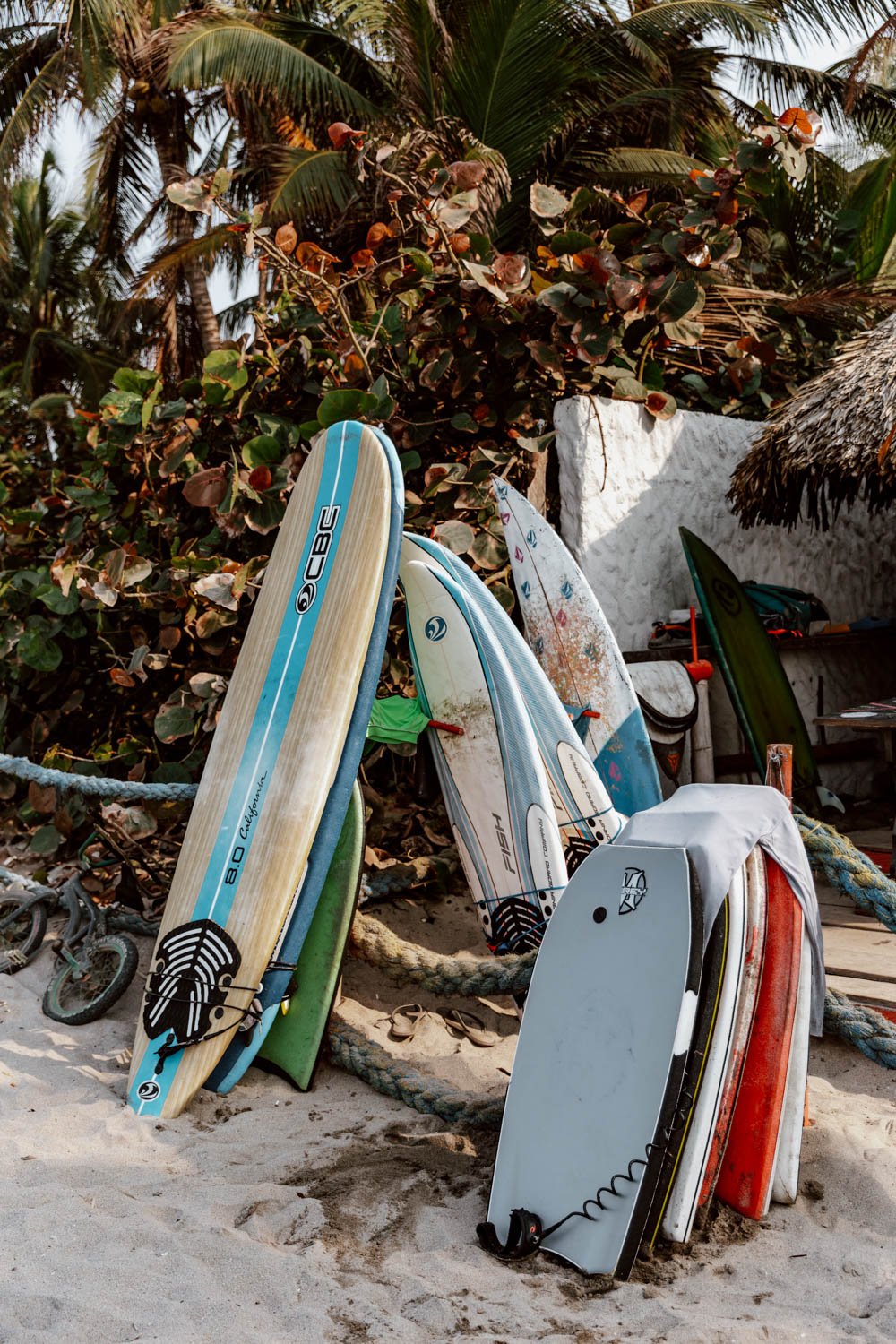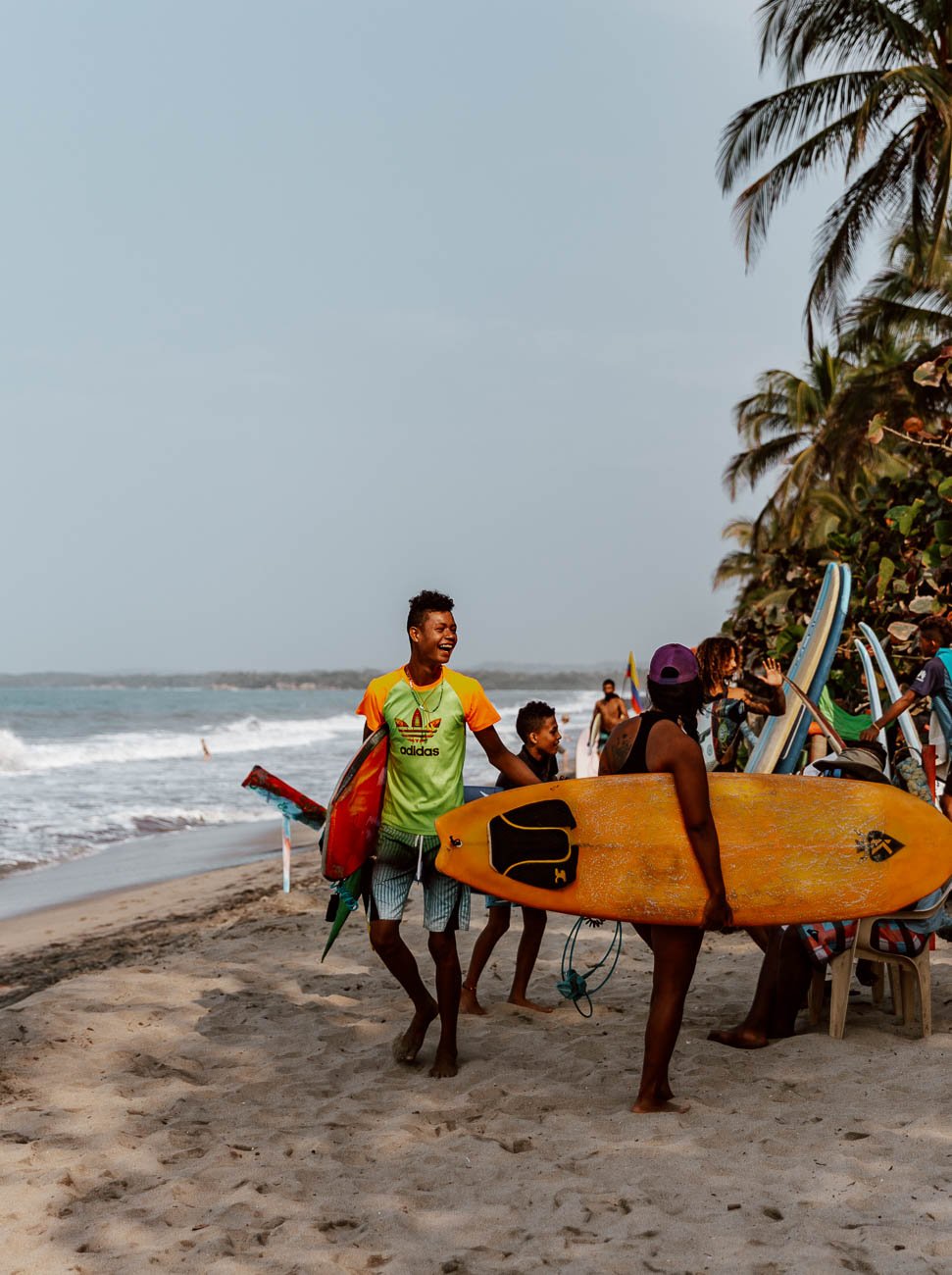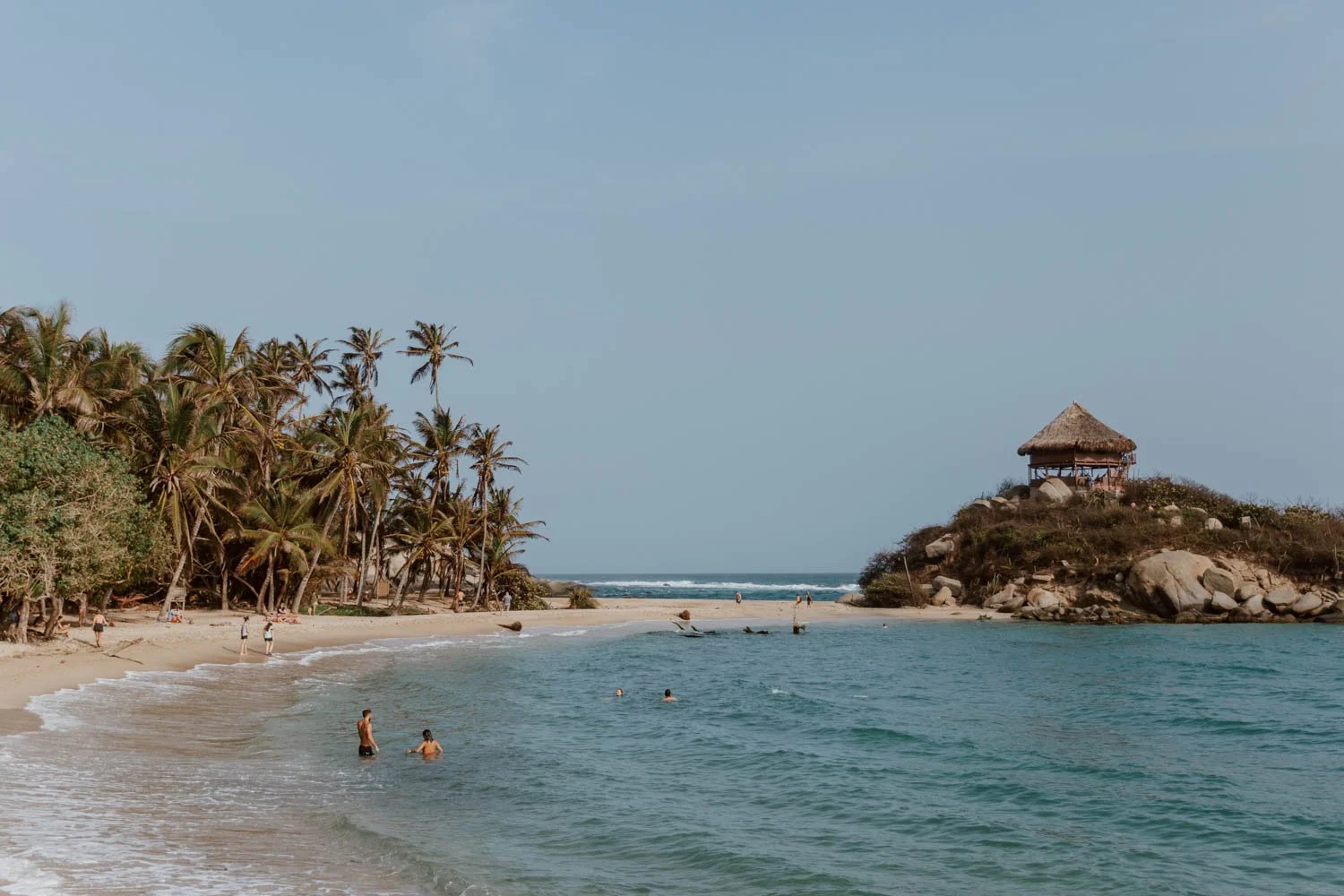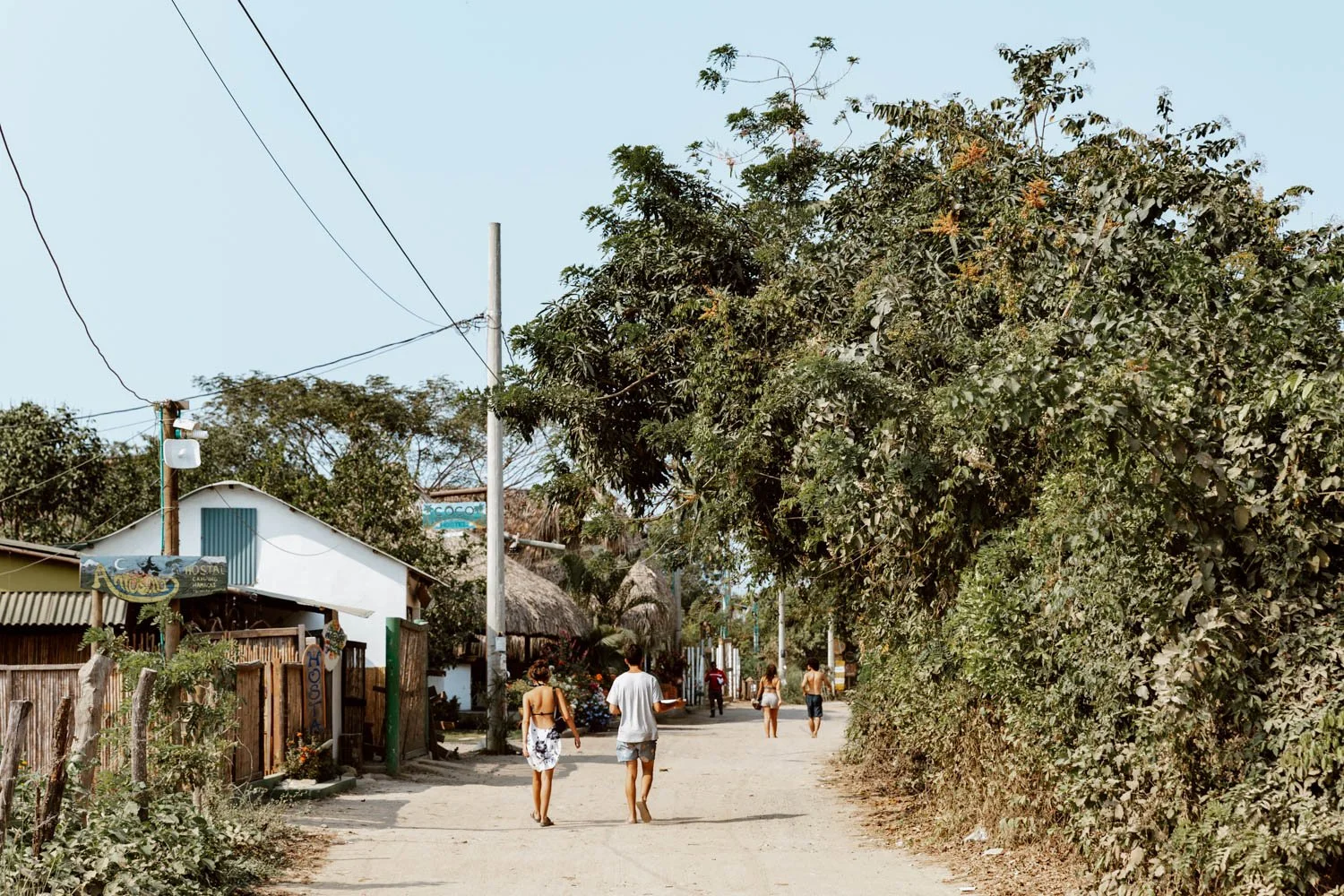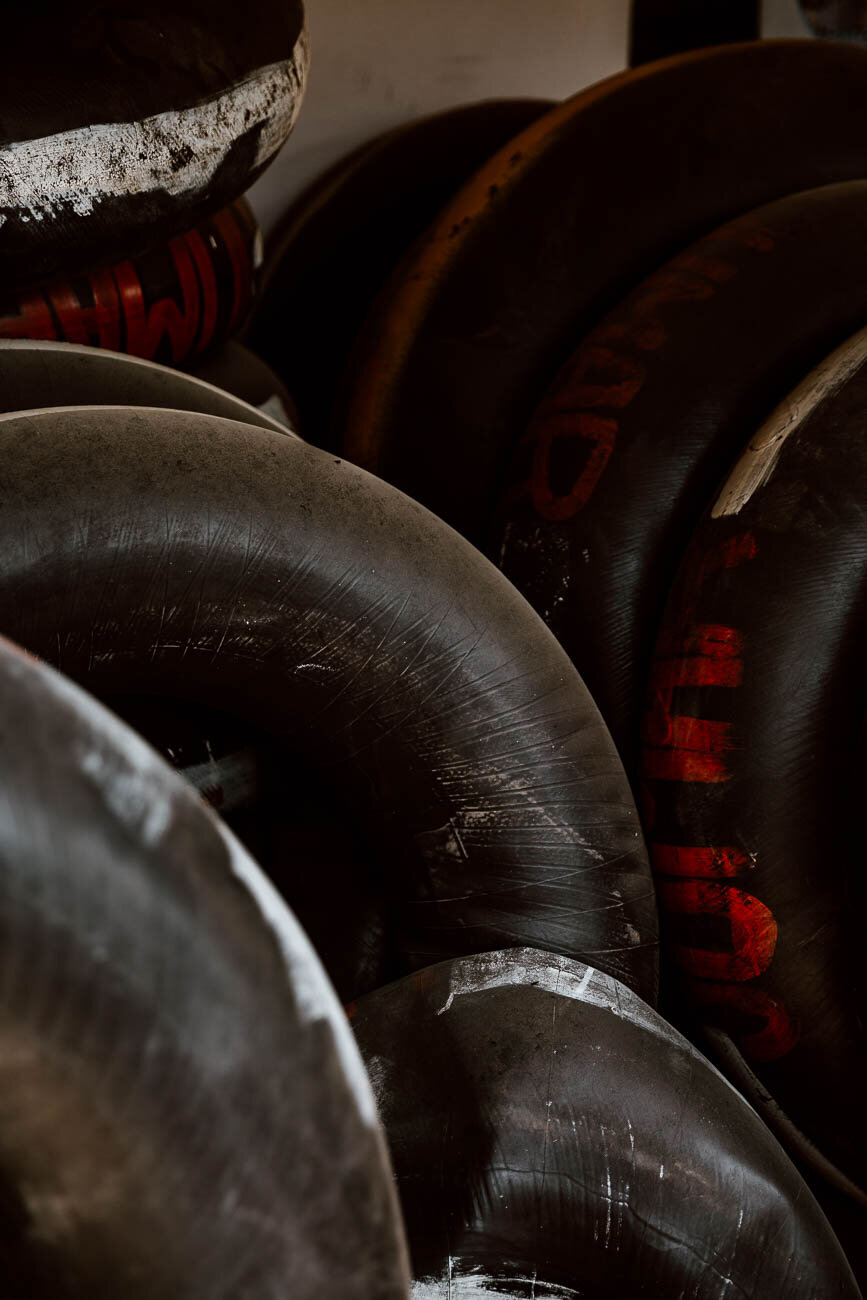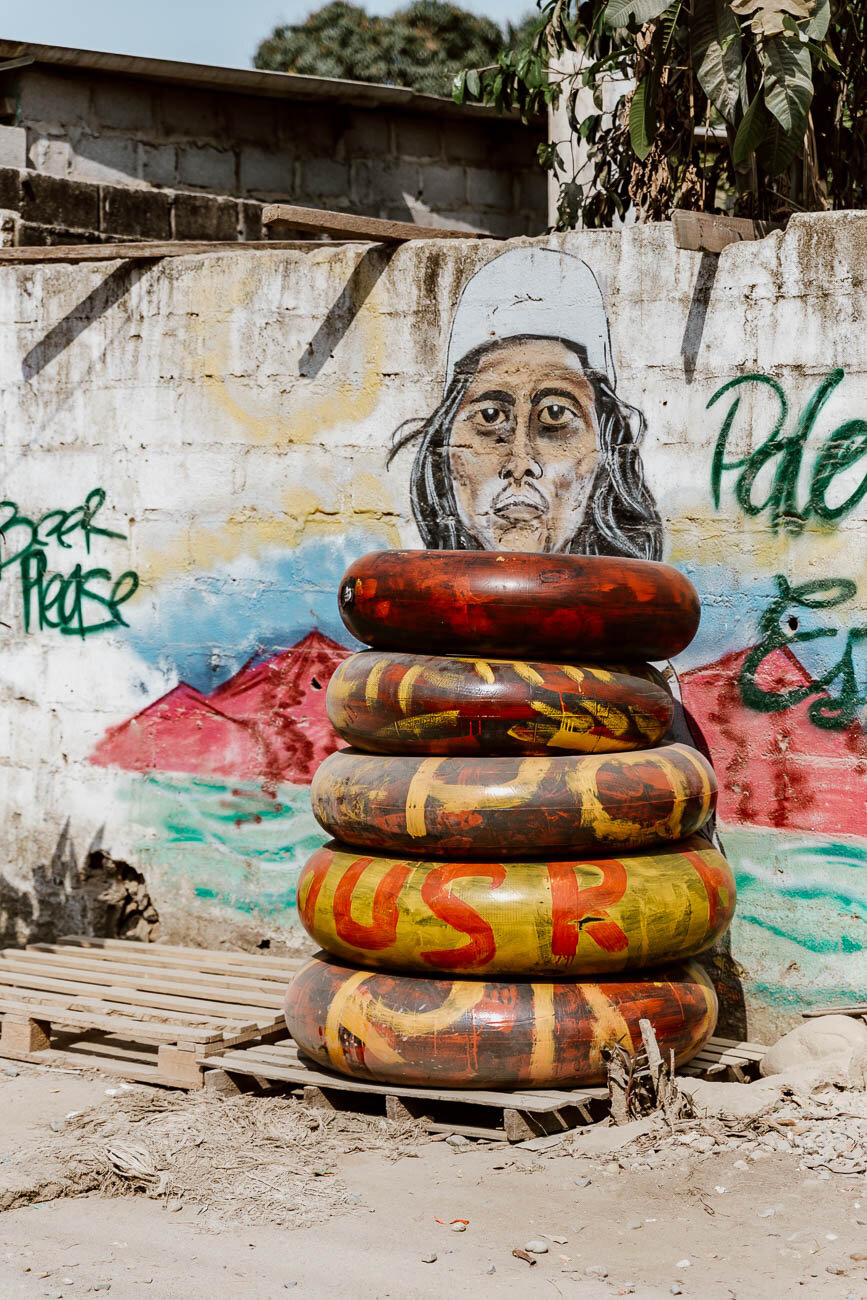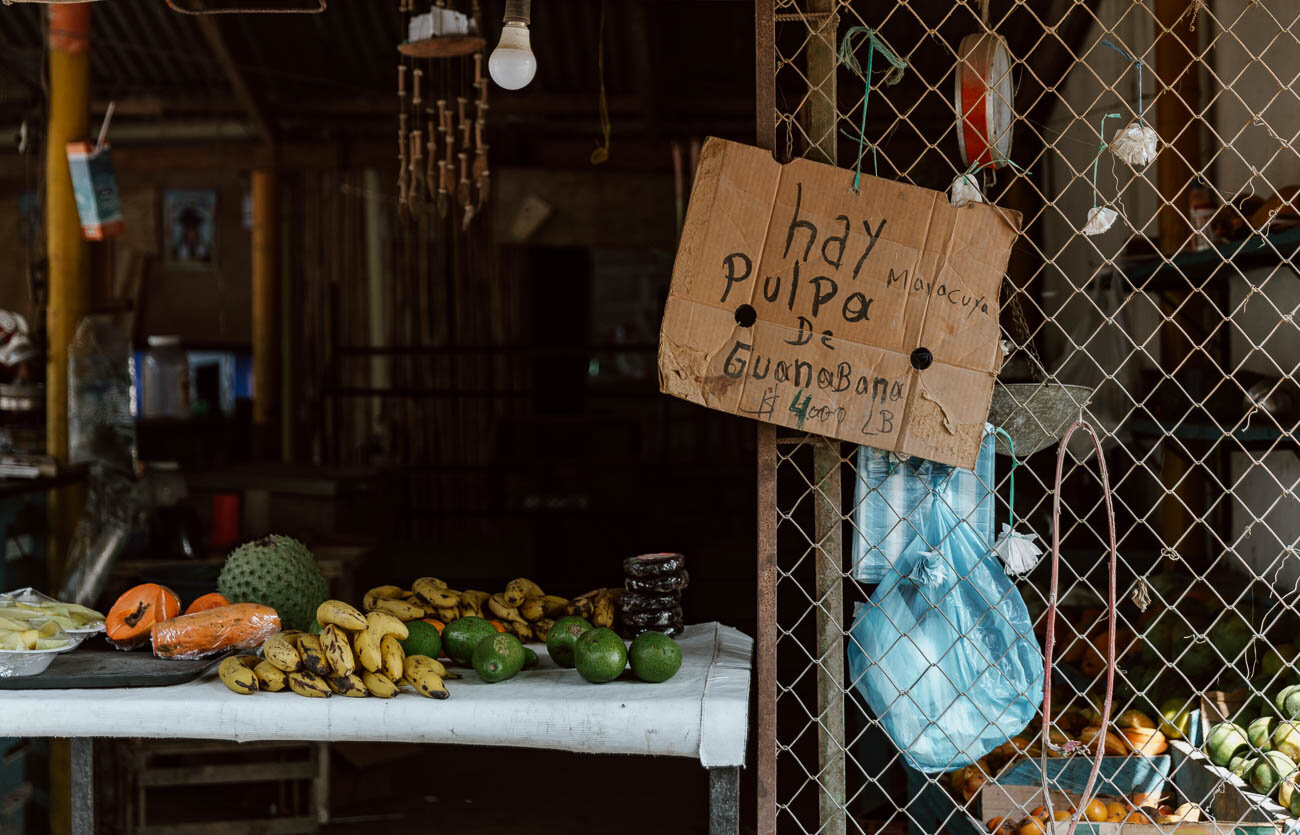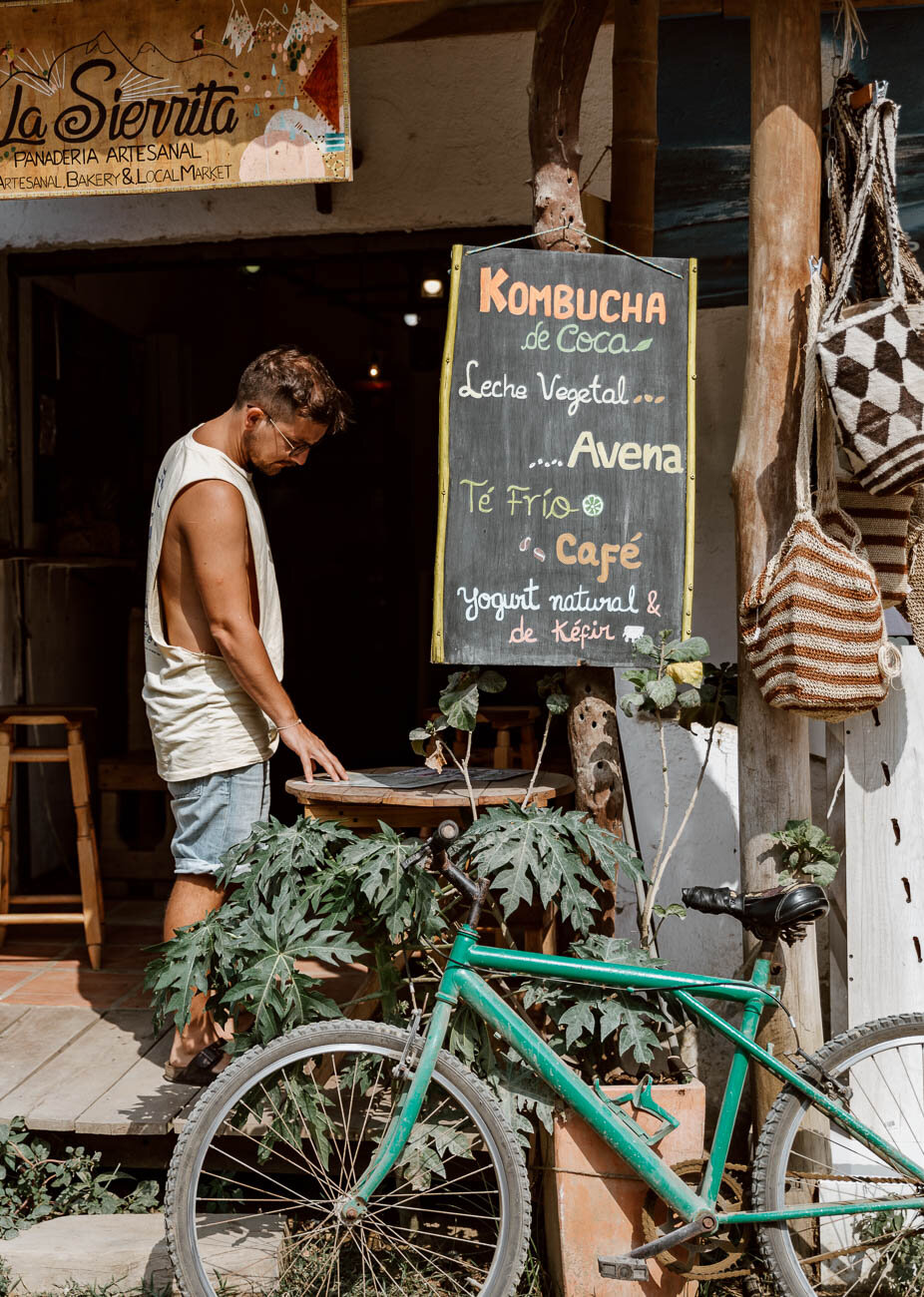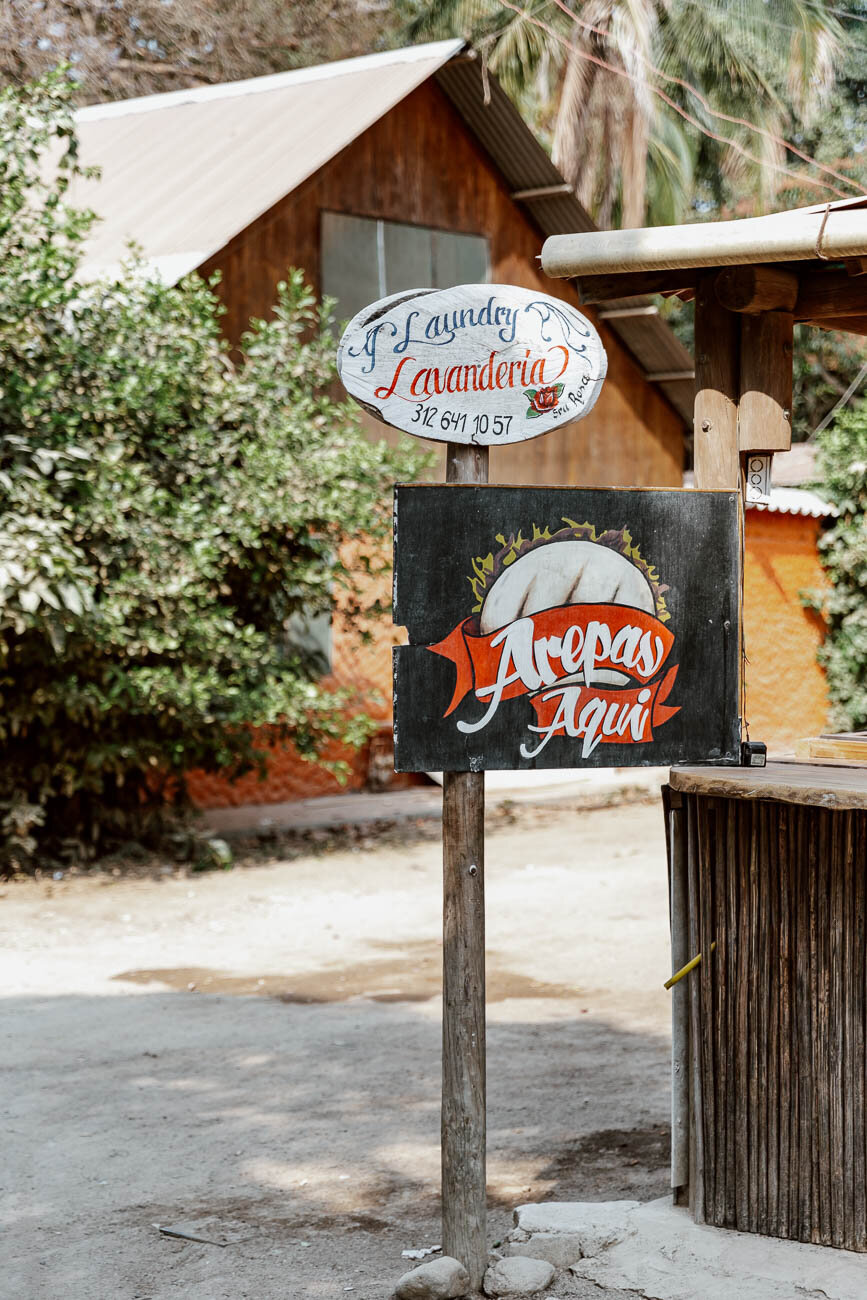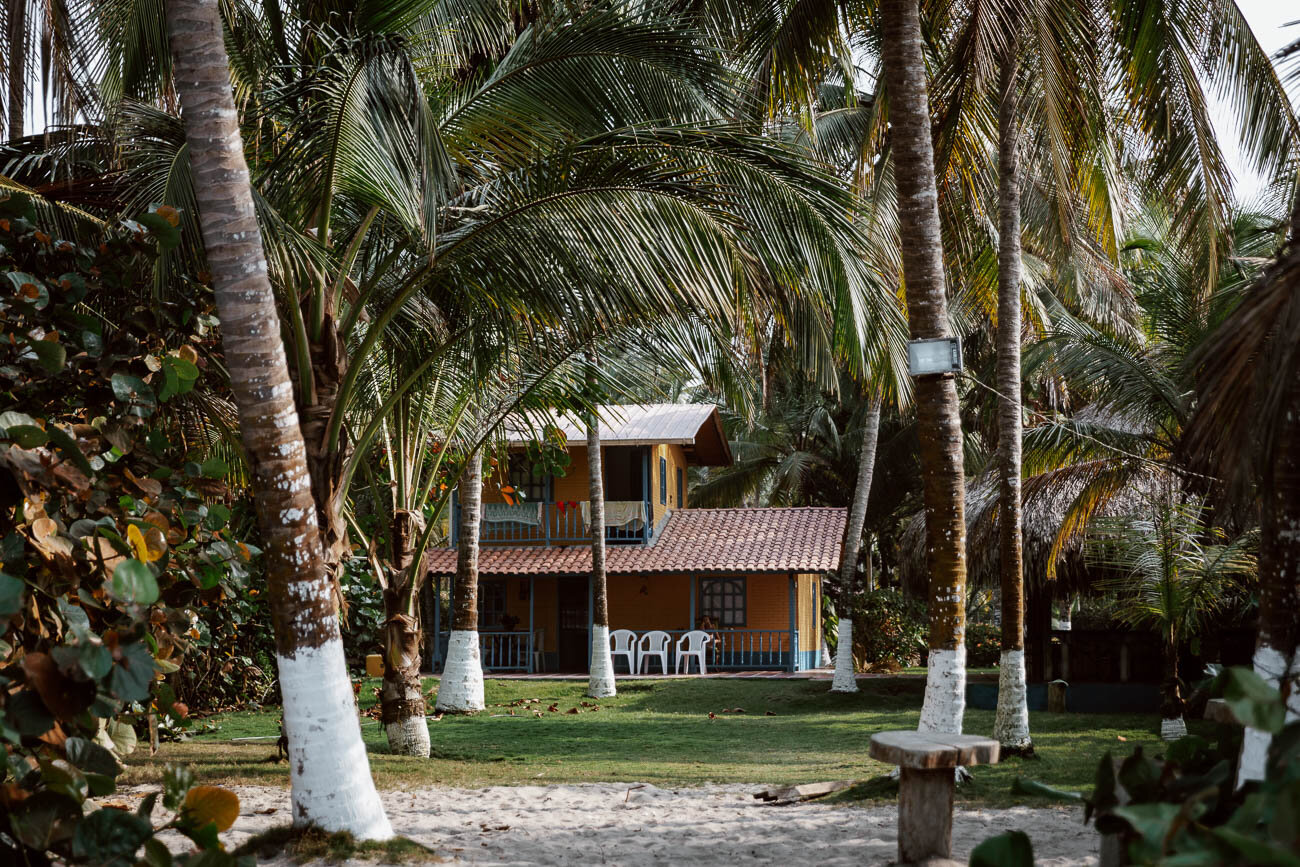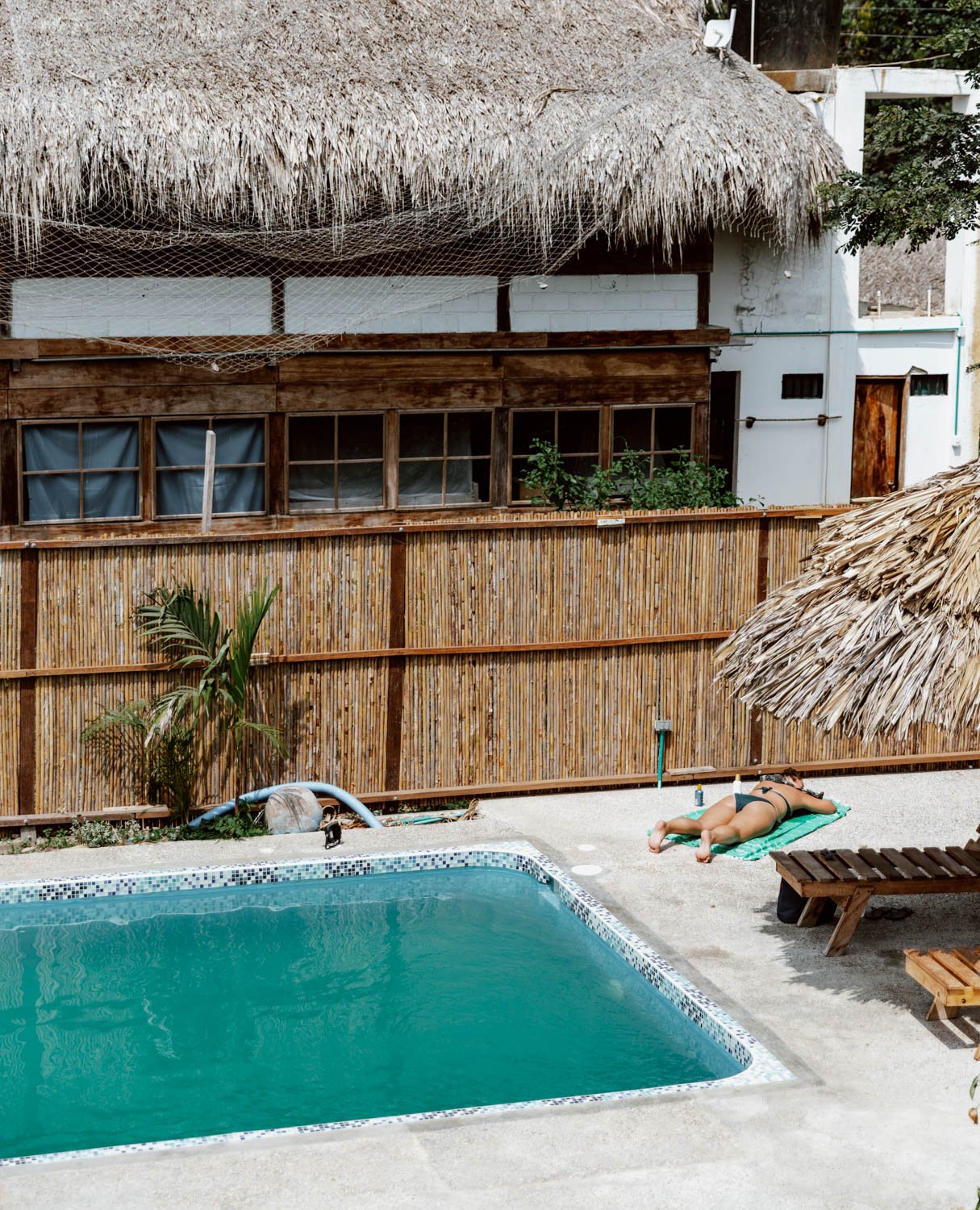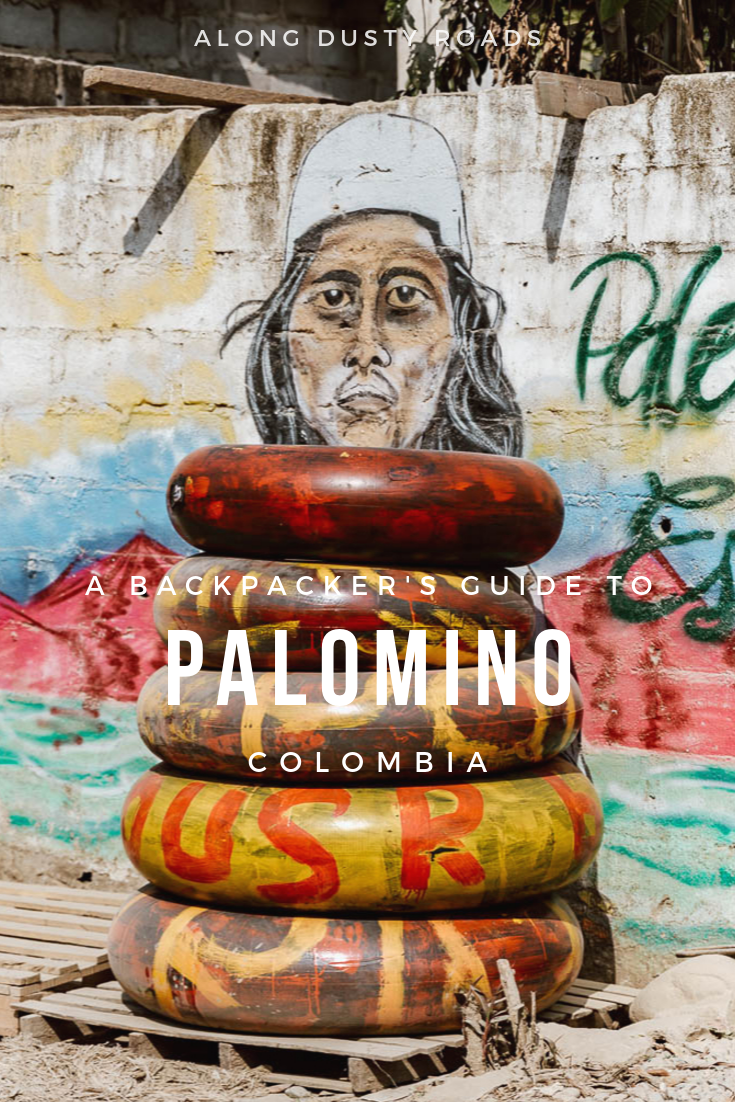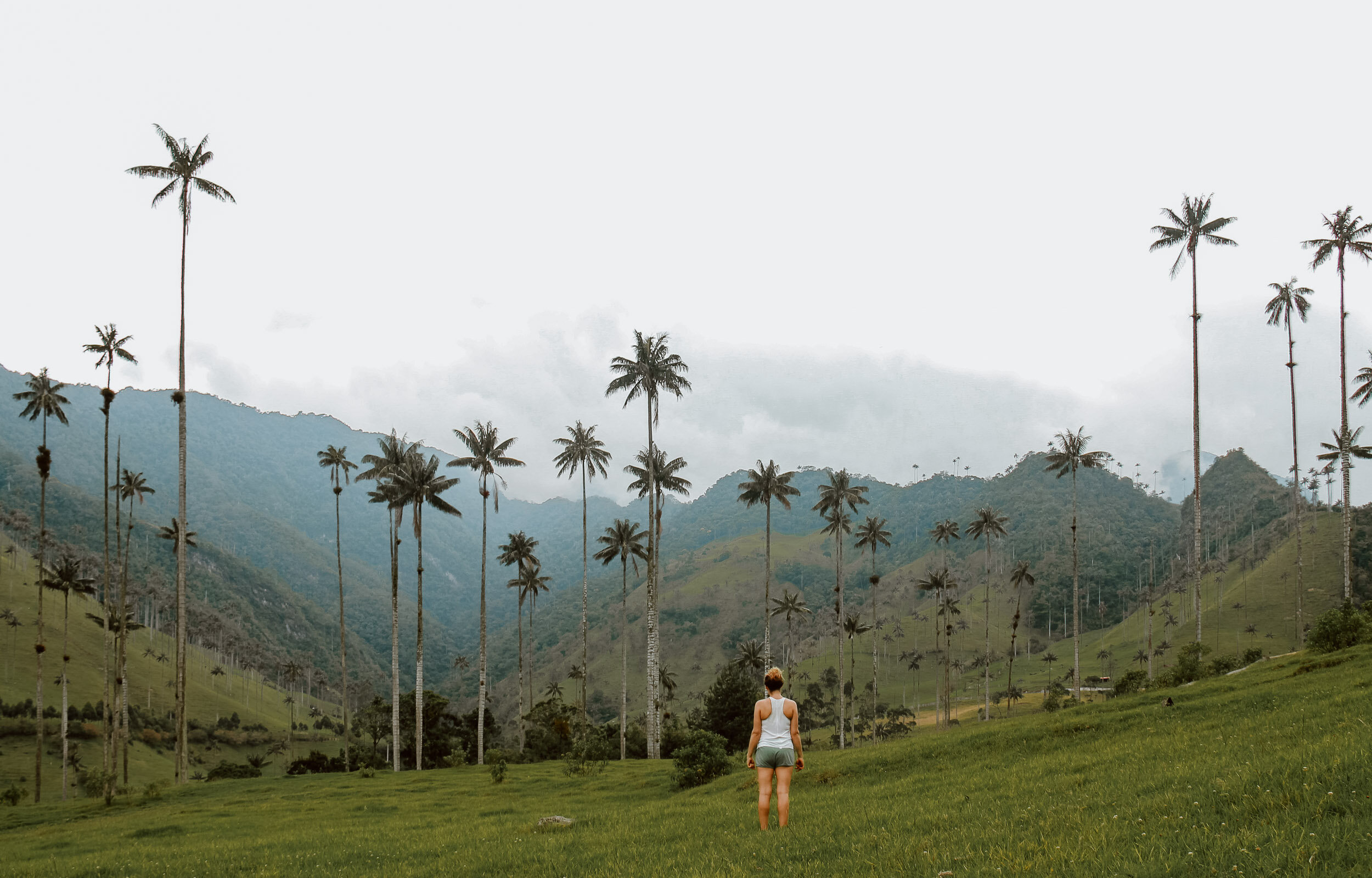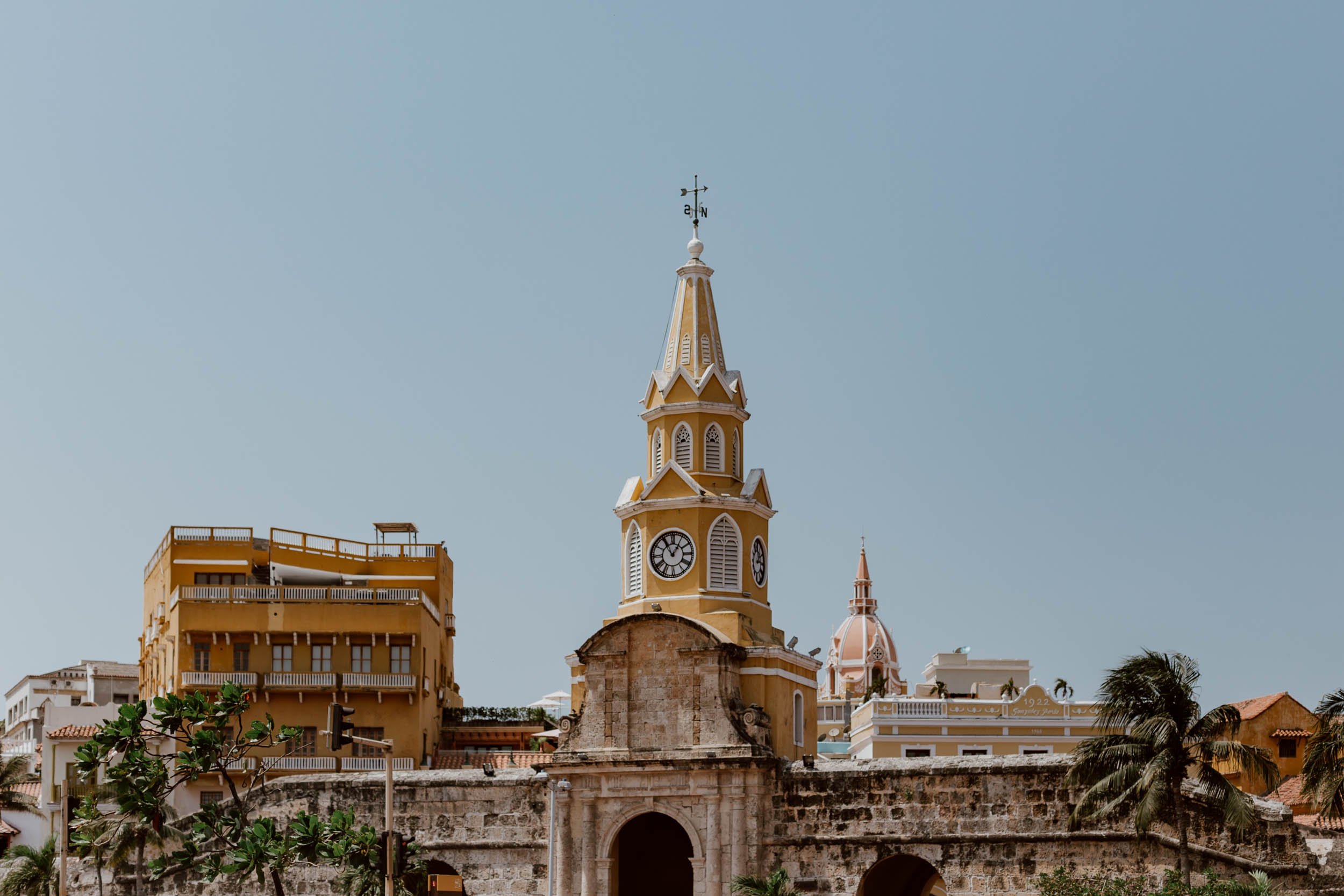Palomino is Colombia’s ultimate backpacker town, and this guide we’ll share with you everything you need to know to plan your visit including the best things to do in Palomino, where to stay, restaurant restaurants and - best of all - where to meet the cutest troupe of doggies, and do your bit to help the local animals.
Updated July 2023
Palomino is the sort of place which changes your plans.
Its pace is slow, its air dry and salty. Its makeshift network of dusty streets, marked out by colourful handpainted signs for homes and hostels, lead through green fields, flowered verges, and open up to the wild sea. There are wooden shacks set up by locals to sell juices from fruit plucked from not too far away, open-sided bars and restaurants with tree trunk seats and tables where travellers shoot the breeze, and stalls laden with jewellery of copper, brass, and almost gold designed, chiselled, and hammered only that morning by the travelling artisan pop up on random corners.
On mainland Colombia, it's the closest place you'll find to the type of backpacker and hippy beach bum destination that is common place across south-east Asia. For some of you right now, that may be exactly what you're looking for; for others, that statement alone may be enough to put you off visiting.
As our visit to the village fell towards the end of our most recent four month South America trip, and directly after five days on the Lost City Trek, we craved somewhere exactly like it. Somewhere chilled out and sunny where we could laze on a white sand beach, sip a few happy hour cocktails, do a yoga class, share tales from the road with others over card games, eat some non-Colombian food, and not touch anything to do with hiking or route planning for four days.
Somewhere to feel a little bit more in 'holiday mode' rather than 'travel mode’.
Our first impressions of Palomino however, in that snapshot moment between the hot bus from Santa Marta dropping us off and our trundling walk from the side of the busy highway through abandoned paths, were not good. But, over the course of a couple of days, we adapted to the pace, the starry-eyed barefoot cliches of some, and began to revel in the laid back atmosphere of a place which bares little resemblance to how it once was only 10 or 15 years ago.
From its rural and remote beginnings off the side of a highway, Palomino village has developed into somewhere where tourism is deciding the destiny and character of everything. There’s a new bamboo walled and palm-leaf roof hostel or restaurant seemingly under construction off every street, and in any space where the field doesn't have roughly written 'no se vende' sign. A bunch of Colombia small-group tours now include a stop here. Palomino stands perhaps as the insurgent popularity of northern Colombia as a destination in microcosm. The pace of change in this small section of one of the poorest departments of Colombia has been very quick, and speaking to locals and longer-term residents, mis-managed and uneven. This will likely only increase in the next few years as more of us choose to stop in Palomino before or after Tayrona, or on their way to an off-the-beaten-track adventure in La Guajira, and Colombia's popularity continues to grow each year.
As ever, when tourism arrives in a place and spread, there are a myriad of positives and benefits. We just just hope that Palomino (and the travel community) learns from the lessons of Taganga a little further west along the coast so that it can thrive sustainably and responsibly rather than suffer the same fate of becoming overrun, debauched, and ruined in a very short space of time.
For the moment, Palomino is far from reaching that precipice. If it was close, we would tell you right now and this guide would have a different tone. However, we both really enjoyed it much more than expected and extended our stay not once, but twice.
After all, it's the sort of place that does that to you.
These are our favourite things to do in Palomino, plus advice on the best hostels for backpackers, a few excellent places to eat, and tips on transport connections to help you plan your itinerary.
our favourite Things to Do in Palomino
take a Beach Day
The reason that most of us travellers meander towards Palomino!
The long narrow beach, flanked by a river on each side and with a palm tree backdrop, is sandy, quite clean, and relatively undeveloped. Although the wind can pick up a little too much at some points in the day and the sand becomes a sliver when the tide is in, it's pretty perfect for finding a quiet spot, laying your towel down, and doing absolutely nothing.
The only downside, and something many travellers don't know before they arrive in Palomino, is that there is one hell of a current in the Caribbean sea and it is not safe to swim here.
We repeat, it is not safe to swim in the sea at Palomino beach.
This is a common occurrence along Colombia's northern coast - for example, there are several beaches in Tayrona National Park where swimming is not permitted - and it's a warning to be heeded. You will see some people ignoring the signs and red flags, or taking the risk, but please don't put yourself in a potentially fatal position if you're not a very strong swimmer.
There are two main points of entry to the beach - the less-trodden one a short walk from Kawabonga Hostel (where we stayed) or the main entrance which is found by walking down the main street from the highway for a 7 or so minutes.
We've put a link here on Google Maps so you can easily find the main entrance point - it’s just after the popular Dreamer Hostel.
If you turn left upon entry and keep on walking, you'll find lots of free space to hang out - and you can keep on on walking to the rivermouth where the tubing finishes. On this side of the beach, Zoe Palomino Beach is a cool place with food, lounge chairs, and drinks.
Turn right and there are more beach-front bars and restaurants to hang out at, plus some of the fancier beach-front hotels (i.e. Makao Beach Hotel). If you keep heading in this direction towards the abandoned tires, beyond these you will eventually reach another beach.
Insider tip // As the sea is dangerous, many hostels in Palomino have a pool perfectly set up for hanging out by all day - knowing this in advance, we chose our hostel specifically because it had a pool to laze by. We've shared our pick of the best hostels in Palomino - including those with the best hangout pools - at the end of this post!
Get Your Doggy Fix
It was on our penultimate morning in Palomino when we saw the sign asking 'Are Your A Dog Lover?' and offering a rescue doggy picnic at the beach.
As animal lovers who literally go goofy over any pup we see anywhere - thinking up back stories, having imaginary conversations, and getting concerned looks from their hoomans - there is a double-edged sword to the street dog situation in South America.
Every day we got to make multiple dog friends, but often our hearts would break.
There are so so many doggies who live on the street, and a good few actually have a home and an owner - they simply take themselves out for walks in the day and have a very different domestic life to pooches back home. They've got a pretty great life actually.
However, for every one of those on the street, there are a rag-tag bunch of dogs with no home and no owner. Some of them get by ok, wandering around the same patch and being looked after by various people, but many are not loved, not looked after, and not in a good way.
We promptly messaged Palomino Animal Soul - the people who put up the sign - but unfortunately it was a little too short notice to join them on full doggy picnic. However, we wanted to find out more about he organisation and the work they were doing to help animals in the village, so arranged to meet at their makeshift shelter a short walk from our hostel.
What we discovered was Karina, an incredible woman doing her absolute best with very little to help rescue and rehabilitate abandoned street dogs and cats, and improve awareness in the local community about animal welfare. Their passion and commitment totally blew us away, and hearing the stories of the various doggies in their care brought tears to our eyes.
So, if you're reading this before your Palomino visit and in need of a doggy fix, please send over a message to Palomino Animal Soul and join them on one of their regular morning doggy beach and river walks, or book one of their doggie picnics on Airbnb! The price of the four-hour picnic experience includes lots of tasty fresh food, takes you along the beach, and LETS YOU WALK AND PLAY AND LOOK AFTER AROUND 10 PUPS FOR A FEW HOURS!
The moneys goes towards helping these two do important work that nobody else is doing in the town*. If you can't do the walk, then donations are also welcomed.
The Details | The best way to get in touch is via Palomino Animal Soul's Instagram or Facebook page. Tell them we said hello! Alternatively, you can find the shelter here on Google Maps.
*There does appear to be another rescue in Palomino - Dog Shelter Palomino - that is also doing the doggy walks alongside helping the local area’s four-legged population. If you’ve had a good experience with them, we’d love for you to let us know in the comments.
With that said, after following Karina and her team’s incredible work since we visited the little beach town, we will always be big supporters of Palomino Animal Soul (in fact, we give 10% of all profits from our print sales to the shelter) and would struggle to send you anywhere else!
Learn to Surf
Despite the rough currents, there are a surprisingly large number of surfers and a couple of surf schools in Palomino, and if you happen to be there when the seas aren’t rough it’s apparently not a bad place to pick up a few lessons.
You can find a few surf schools on the right hand side of the beach, and the Dreamer Hostel also offers lessons. Expect to pay around $150,000 COP for a private class, or $100,000 COP to join a group. You can also rent boards by the hour.
Top Tip // If you’re keen on really getting to grips with the waves, you could consider this 5-day surf safari along Colombia’s Caribbean coast which includes time in Palomino.
Visit Tayrona National Park
Although our two-day visit to the beautiful beaches of Tayrona National Park didn't totally meet our expectations, there's zero risk that it's going to be dislodged from its place at the top of most first-time Colombia itineraries. And with regular bus connections along the Troncal del Caribe highway between Palomino and Tayrona, it makes perfect sense to combine the two on your itinerary.
From Palomino, simply catch the bus in the morning from the highway (on the corner of Carrera 6a and 7a is the best spot - they often park and wait here). Any bus passing by here on its way to Santa Marta will be passing the Tayrona entrance, but it's ways best in Colombia to confirm with the driver that they'll stop outside there. It's a 40-minute ride, and we paid 7,500 COP each.
The park entrance will be on the right hand side of the bus as you travel, but the driver should give you a shout - you likely won't be the only person looking to disembark there.
If you are choosing to visit Palomino directly after spending a day or two in Tayrona, then you can simply stand outside the entrance and hail one of the passing buses. As they're running from Santa Marta, they'll be quite frequent and will usually have space as people get off for Tayrona.
Whether you're going for a day trip to Tayrona or to stay for a night or two, we highly recommend that you set off early from Palomino and aim to arrive at the entrance before 8 am (therefore beating the majority of other travellers making their way from Santa Marta).
Tickets cost 68,500 COP ($16 USD) in the high season and 57,500 COP ($13.5 USD). You used to be able to buy them online, but this seems to be have been suspended, therefore your only choice is to queue up and buy one at the entrance upon arrival. Given Tayrona’s popularity, and the inevitable queues, it’s for this reason that we recommend leaving early from Palomino!
For more information on how to plan your visit, costs, and accommodation options, read our guide to Tayrona National Park.
Top Tip // If visiting during the wet season (or the beginning of the dry season), another popular day trip is to the Quebrada Valencia. Located around 30 minutes from Palomino, after a half-hour forest walk along a dusty trail, you’ll reach a small, wide rocky waterfall that empties out into a pool below - the perfect antidote to those hot and humid days!
To reach the Quebrada Valencia, hop on a bus heading to Santa Marta (from the main road) and let the driver know where you want to get off. We believe there’s now a 3,000 COP entry fee to the falls, but would love if someone could confirm this in the comments!
River Tubing
We were too busy enjoying ourselves at the beach, the pool, and on the dusty streets to bother doing the tubing, but heading down the river in a inflated inner tire tube is one of the most popular things to do in Palomino. From previous experience of tubing in Laos, your best bet is to go with a decent group of people at the same time and bring a few beers.
All hostels and various guys along main street offer daily tubing excursions, which are apparently all much of a muchness but may involve different 'push in' points on the river. Tubing in Palomino involves 15 minute drive with motorbike or truck (you have to carry the tube), then a 30+ minute walk through the trees, before setting off for 90 minutes to 2 hours down the river to the beach. Expect to pay $40,000 - $50,000 COP per person all in, and you'll spend about 3 hours on the experience from start to finish.
Before you leave, remember to slap on sunscreen, wear flip-flops, don't take anything you don't want to get wet or lose in a river, and a few beers for the ride. With any activity like this, it's best to do it in the morning or early afternoon to prevent any nighttime mishaps if everything goes, quite literally, up shit creek without a paddle (that may also be speaking from experience…)
Remember to take all rubbish back with you from your tubing experience and dispose of it appropriately.
Eat. Eat. And Eat Some More!
We arrived to Palomino with no desire to do our usual thing of hostel cooking and budget eating - we wanted to gorge on big plates of backpacker burgers, pizzas, and noodles.
And, for such a small place, this is where Palomino really excels - especially for vegetarian and vegan options. You'll find most clustered on the main strip (Carrera 6a) in the area between Calle 2 and Calle 4a, and then again close to the main beach entrance and on the beach itself. However, it's worth noting that several places and food stalls only open from late afternoon onwards. Indeed, by the time you read this guide, it's likely that dozens of little restaurants and guys with grills will have come and gone, as that seemed to be the way in Palomino, but the below were our absolute favourites!
Turcolandia (maps) | It may not look like much from the outside, but this place on the main street was a bloody great find. With fresh pasta and sauces made on site, and a not half bad house wine, we had to go there twice. If you're a little hungover or in need of a carb-party, then order the Ravioli Caprese and thank us later. They also serve pizza, but we didn't try them.
Juntos (maps) | A good deal fancier than Turcolandia, this place has the Bali vibe down to a fine art with its driftwood, rope, and plant decor. The veggie burger and pad thai hit the spot, but the service was a little lacking. It also hosts late night live music on certain nights. An alternative place with a similar vibe is Suá, just a little down the road.
Los 7 Mares (maps) | As the main road approaches the beach, Los 7 Mares (The 7 Seas) stands out as a place that's put a great deal of thought into its design and philosophy. The menu is seasonal and organic, with local and sustainable ingredients at its heart. It's one of the few places in town where the focus is on local dishes too - but with a modern twist. It's a little more refined and expensive than backpacker restaurants in Palomino, but worth it - especially if you want seafood.
La Happycleta (maps) | A little off the main drag, the little bamboo complex of La Happycleta had only recently opened up but was our sort of place. Run by a bunch of hippies, it has 3 little restaurants within the same space (each has its own little cooking area), where you could opt for tacos, Ecuadorian food, and something we can't remember. Lots of veggie and a few vegan options, with a relaxed slow food vibe.
Barba Beach Arabic Food (maps) | One of the few places in Colombia where we could get a falafel wrap fix! Not the best in the world, but hit the spot and excellent value. It's opposite Turcolandia. (we’re fairly certain this used to be called Salomé, but we DEFINITELY don’t mean the Latin restaurant next door).
The Juice Ladies | They've got no sign, but we'll call them the juice ladies. If you're in Colombia for 2 weeks or 2 months, you HAVE to make the most of the wonderful fresh tropical fruit juices (with or without milk) which are the local staple. The stand, on the left of the main road as you approach the beach, is run by two friendly local woman - pick your fruits, choose milk or no milk, and enjoy!
La Sierrita (maps) | A teeny tiny hipster bakery heaven. The vegan cinnamon rolls are in-cred-ible.
Casa Cocotte (maps) | A French-owned restaurant within a lovely garden, where the focus is as much on the food as it is about doing good. Offering a daily changing menu based on what’s available (always with a veggie/vegan option), they also provide a development programme for their local chefs. As one would probably expect, meals are a little on the pricier side but of excellent quality.
We also have to give a special shout-out to the guy who turns up in the evening with his own burger grill and homemade signs - we regret to this day not getting a photo of his wonderful pop-up!
There are obviously a lot of businesses in Palomino which are not owned by those from the village, it’s therefore really important, where possible, make some of your traveller pesos also land in the pockets of the local community. If you are opting to cook at your hostel, there are a few shops and stalls with fresh fruit + veg etc on the main road, closer to the highway, and on the highway itself. If you are in Colombia for a short trip, then try to eat an almuerzo (lunch) at one of the cheap local places you can find at various points on the main street, with a bunch close to the highway.
Where to Stay in Palomino
Picking the right accommodation in Palomino is key to your experience, as you're naturally going to be spending quite a bit of time hanging out there - that’s part of the vibe.
If you're on a tight budget, you will easily be able to rock up off the bus and find a bed for the night at a cheap local guesthouse, but if you want somewhere with a great social vibe and a decent pool, then you need to book ahead.
Prices along the northern coast of Colombia are more expensive than in the southern and central areas, but a good dorm can still be found in Palomino for £6-10 per person. Private room prices vary wildly in affordability however, with some hostels here charging £40+ for not very much. Note that Colombians absolutely love their holidays, so if you are visiting Palomino in December, January, or during the Semana Santa break, expect increased prices, increased crowds, and much reduced availability of accommodation. Additionally, this was one of several places we visited along the Caribbean coast where good hostels really do tend to get booked up in advance, so if you find one you like the sound of, we’d recommend booking before you arrive.
These our our pick of the best hostels, guesthouses and Airbnbs in Palomino for travellers (each also has a private pool) - and one wildcard for travelling couples looking for somewhere a little more special.
Kawabonga | After a lot of research before we arrived, we booked Kawabonga for its relaxed but social traveller vibe and the pool - we were really happy with our choice. It's got a few cats, a cheap guest-bar that opens until 11 p.m. (where we spent most evenings - and our money), hammocks, and a really nice fresh fruit and pancake breakfast too. It's got dorms and privates.
Check availability or make a booking on here.
The Dreamer | The go-to place for backpackers in Palomino, it was fully booked out when we visited. It's really close to the beach, has a huge pool, lots of communal social areas, and is set within large private tropical grounds. It's got lots of affordable dorms and 20 or so private rooms (but we think the private double rooms are overpriced).
Check availability or make a booking on Hostelworld or Booking.com
Casa del Pavo Real | A short walk from the beach, this boutique hostel has Condé Nast Traveller levels of aesthetics, and whilst there prices have risen steadily as their reputation has grown, the standard of accommodation makes it a worthy splurge for those that can afford it (especially solo travellers staying in the surprisingly affordable dorms). It's a more relaxed hostel rather than a party one, with a lovely pool and highly recommended breakfast included.
Check availability or make a booking on Hostelworld or Booking.com
Primaluna Beach Hostel | Another one for social solo travellers or groups, it's close to the beach, has a big pool, lots of communal spaces, and an on-site restaurant with breakfast included with your room booking. You can book on Hostelworld and Booking.com
Makao Beach Hotel | With a private beach area, seaviews from your room's balcony, and a crisp, clean design, Makao is the option for couples who want to relax their travel budget, treat themselves to a hotel rather than hostel experience, and enjoy somewhere a little fancier than they've been used to on the road thus far. It's also cheaper than many other beachfront hotels in Palomino. If you're a couple looking for a beautifully designed private room in a hostel by the beach, then this is the one for you.
Check availability or make a reservation here.
Note that the beach and several of the best hostels in Palomino are a 10-15 minute walk from the highway drop-off point, so you may want to take a a mototaxi down the road if you have a lot of weight on your back or it's dark.
If you think another hostel in Palomino deserves to be on this list, then let us know in the comments!
Useful Palomino Travel Tips
ATMs in Palomino | Before you make any tracks toward Palomino or Tayrona, you need to know that there’s no ATM in town and many businesses will not accept card (the larger hostels and restaurants do though). It’s best to bring enough cash with you from Santa Marta or elsewhere.
If you're running low on funds, then the closest cash machine is a moto-taxi (quickest option costing 10,000 COP) or a 5,000 COP bus ride away in the town of Mingueo.
The darkness | Although small and undeveloped, it's very easy to get lost in amongst the trees and dead-end dusty paths in Palomino, especially after dark. As there are very few streetlights, make sure you bring your mobile phone or head-torch to light the way home!
Bad internet | One half of Along Dusty Roads was quite delighted to discover that the internet across Palomino was universally pretty bad as this meant we could spend more of our days by the beach rather than working on the blog! If you're a digital nomad and thinking that Palomino may be the perfect base for a few weeks, then just be aware of this in advance. Perhaps some hostels have a better set-up, or the connection will improve in the next year or two, but for the moment this is the only thing that stops Palomino from being a total digital-nomad haven.
How To Get To Palomino
If you're going to Palomino, then you're likely going to be travelling eastward along the coast from Santa Marta.
The city isn't one of Colombia's finest, but it's gritty, authentic, and the main jumping off point for Lost City Trek tours. The good news is that, along the single stretch of the arterial highway calle Troncal del Caribe - which snakes its way from Santa Marta toward Cabo de la Vela, the most rugged and remote area of Colombia we've visited - you can find several of the Caribbean coast's best beaches and attractions. This means the public transport connections are frequent and straightforward.
Santa Marta to Palomino Bus
They leave daily and regularly, but you have two options.
If you're based in the centre of Santa Marta, then head to the intersection of Calle 11 and Carrera 9 at the market (the same spot for Minca + Tayrona bus connections). Travel time is 2 hours with buses departing every 15-30 minutes. A ticket costs 10,000 COP.
Buses also run to Palomino from the Santa Marta Bus Terminal, which is a 10-15 minute, 6,000 COP taxi ride from the city centre. Most of the buses you want will be travelling to Riocacha or Maicao, and prices are more expensive generally. Berlinas, Brasilias, and Superstar are the companies to look for.
We went to all the companies and bargained as much as we could on the tickets (you can do this in Colombia with bus companies), and paid 15,000 COP each.
Whilst we don’t think that this is necessary given the regular bus service, for those that would prefer a private transfer from Santa Marta to Palomino (or vice versa), you can book this highly-rated option in advance.
Read our Santa Marta guide to decide whether you need to include it on your itinerary, or whether you simply need to pass through!
Cartagena to Palomino Bus
It's a long old way from Cartagena to Palomino with public transport (8-9 hours), and we wouldn't recommend trying to do it in a single day. If you insist on it however, then the route would be pretty straightforward with a bus from Cartagena to Santa Marta, then a change over for a bus to Palomino.
Read our guide on the best things to do in Cartagena for more inspiration and information.
Tayrona to Palomino Bus
As we mentioned above, it's very easy and quick to get between Tayrona and Palomino by bus - just hang out at the entrance and flag down any bus that's heading in the direction of Riohacha.






